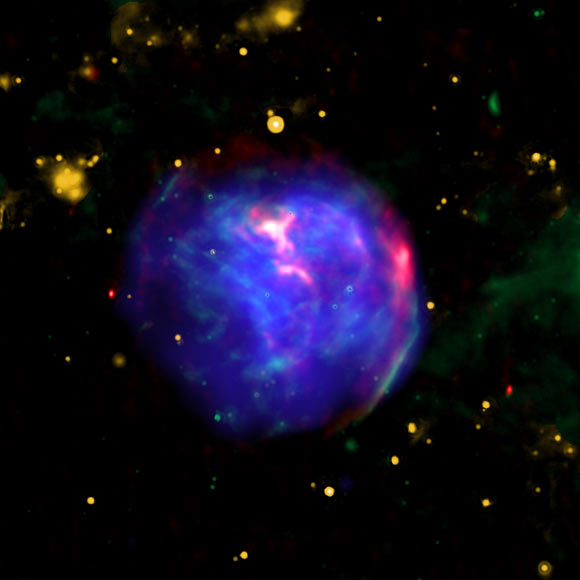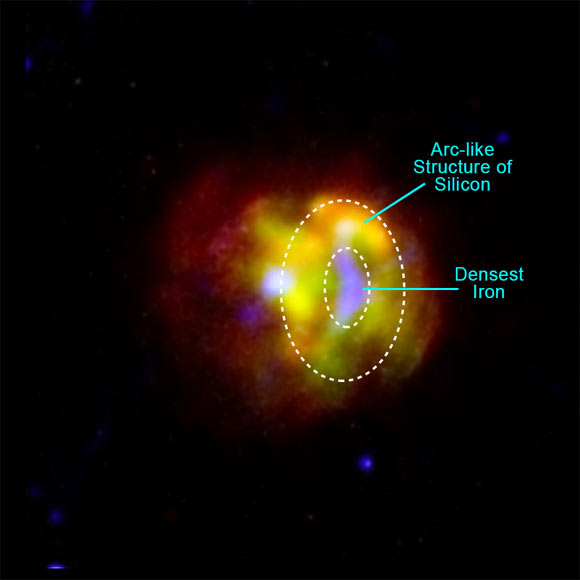The Type Ia supernova remnant (SNR) G344.7-0.1 resides about 19,600 light-years away in the constellation of Scorpius.

This composite image shows SNR G344.7-0.1 through the eyes of different telescopes: X-rays from Chandra (blue) have been combined with infrared data from NASA’s Spitzer Space Telescope (yellow and green) as well as radio data from the NSF’s Very Large Array and CSIRO’s Australia Telescope Compact Array (red). Image credit: NASA / CXC / Tokyo University of Science / Fukushima et al. / JPL / Spitzer / CSIRO / ATNF / ATCA.
Type Ia supernovae are thought to result from thermonuclear explosions of white dwarfs in a binary system.
Since the peak luminosity in the optical part of the spectrum is almost uniform among these explosions, they can be utilized as distance indicators in cosmology.
Type Ia supernovae also play an important role as major suppliers of iron, contributing to the chemical enrichment of our Milky Way Galaxy.
Despite this importance, however, many fundamental aspects of these events remain elusive.
X-ray observations of supernova remnants offer a unique way to address the relevant open questions, as they allow us to measure the composition and distribution of heavy elements that were synthesized during the stellar explosion.
“We estimate that SNR G344.7-0.1 is about 3,000 to 6,000 years old in Earth’s time frame,” said Tokyo University of Science astronomer Kotaro Fukushima and colleagues.
“On the other hand, the most well-known and widely-observed Type Ia remnants, including Kepler, Tycho, and SN 1006, have all exploded within the last millennium or so as seen from Earth.”
“Therefore, the deep look at G344.7-0.1 with NASA’s Chandra X-ray Observatory gives us a window into an important phase later in the evolution of a Type Ia supernova remnant.”

This three-color Chandra image of SNR G344.7-0.1 shows that the densest iron is located to the right of the supernova remnant’s geometric center; this asymmetry is likely caused by gas surrounding the remnant being denser on the right than it is on the left. Image credit: NASA / CXC / Tokyo University of Science / Fukushima et al.
X-rays in supernova remnants are produced by both the expanding blast wave and the stellar debris.
As the debris moves outward from the initial explosion, it encounters resistance from surrounding gas and slows down, creating a reverse shock wave that travels back toward the center of the explosion.
This process is analogous to a traffic jam on a highway, where as times passes an increasing number of cars will stop or slow down behind the accident, causing the traffic jam to travel backwards.
The reverse shock heats the debris to millions of degrees, causing it to glow in X-rays.
Type Ia remnants like Kepler, Tycho and SN 1006 are too young for the reverse shock to have time to plausibly travel backwards to heat all of the debris in the remnant’s center.
However, the relatively advanced age of SNR G344.7-0.1 means that the reverse shock has moved back through the entire debris field.
“The Chandra image of SNR G344.7-0.1 shows that the region with the highest density of iron is surrounded by arc-like structures containing silicon,” the astronomers said.
“Similar arc-like structures are found for sulfur, argon, and calcium.”
“The Chandra data also suggest that the region with the highest density iron has been heated by the reverse shock more recently than the elements in the arc-like structures, implying that it is located near the true center of the stellar explosion.”
“These results support the predictions of models for Type Ia supernova explosions, which show that heavier elements are produced in the interior of an exploding white dwarf.”
The team’s paper was published in the Astrophysical Journal.
_____
Kotaro Fukushima et al. 2020. Element Stratification in the Middle-aged SN Ia Remnant G344.7-0.1. ApJ 897, 62; doi: 10.3847/1538-4357/ab94a6







